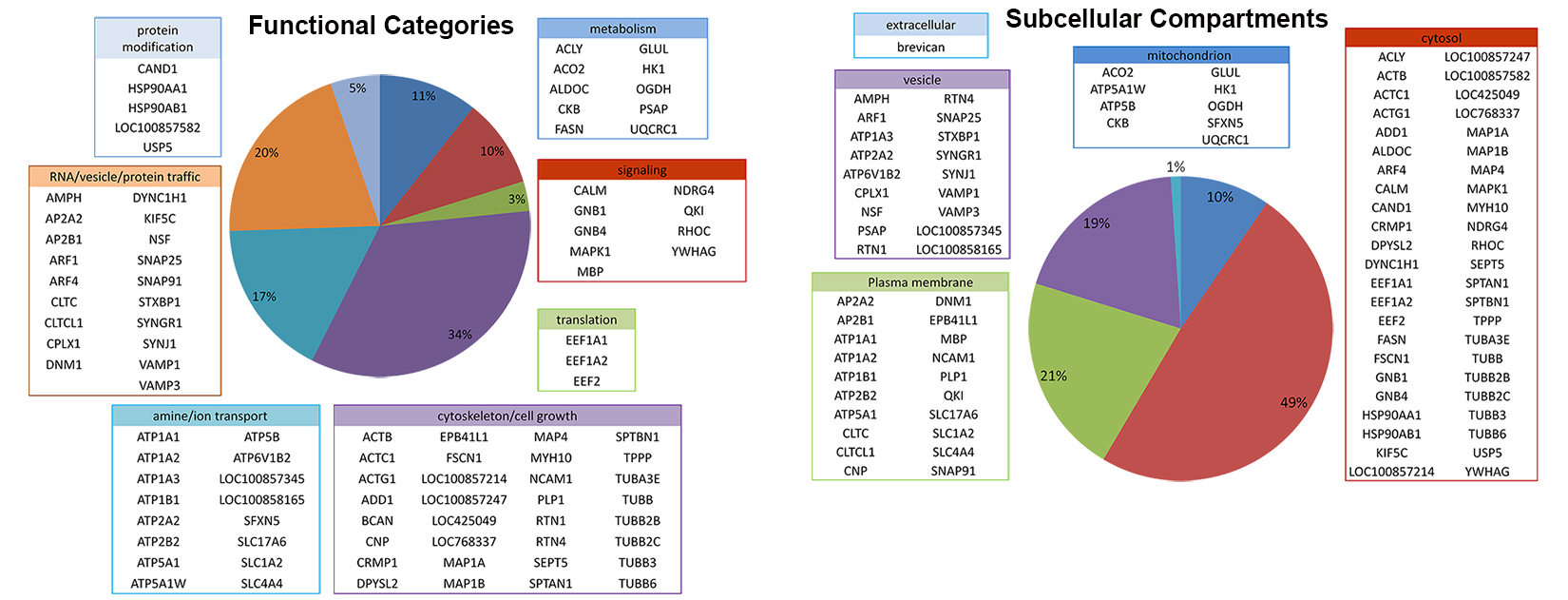Chicken Proteomics
Original Publication: Sakano H, Zorio DAR, Wang X, Ting YS, Noble WS, MacCoss MJ, Rubel EW, Wang Y (2017). Proteomic analyses of nucleus laminaris identified candidate targets of the fragile X mental retardation protein. J Comp Neurol. 525(15):3341-3359. PDF
Animals
This study was performed on White Leghorn chick hatchlings (Gallus gallus; post-hatch day 0-4). The first sample type was collected specifically from the NL cell group under a laser micro-dissection microscope (LMD-6000; Leica Microsystems). The second type of tissue sample was collected from the dorsal brainstem at the caudorostral level of NL. Protein preparation was performed, followed by trypsin digestion and peptide purification for mass spectrometry.
Mass spectrometry (MS)
The LTQ-FT Ultra (ThermoFisher Scientific) mass spectrometer was used. Spectra were matched to peptide sequences using SEQUEST. Peptide-spectrum match and peptide identifications were obtained from Percolator (v2.01). Peptides with Percolator with q-value <0.01 were given as input to ID Picker for protein identification. We used a decoy database using scrambled Gallus gallus genome sequence (build 12/17/11). We required at least 2 peptides per protein, each with a q-value (false discovery rate) of <0.01. At least four biological replicates with three technical replicates each were performed. We required each peptide to present in every technical replicate (n=3) and at least 2 peptides per protein for identification.
Several software programs were used to perform gene ontology analyses of the identified proteins. The first is the DAVID Bioinformatics Resources 6.8 (https://david.ncifcrf.gov/). We used this resource for protein functional annotation and gene ID conversion. Ensembl Bio-mart software (http://www.ensembl.org/biomart/martview/) was also used for gene ID conversion. For identifying transmembrane proteins, we used the TMHMM program version 2.0 located at: http://www.cbs.dtu.dk/services/TMHMM/. Finally, we used the Ingenuity pathway analysis at http://www.ingenuity.com/ as an alternative approach to DAVID for identifying enriched pathways.
Download: Identified Proteins in NL samples Identified Protein in BS samples (dorsal brainstem)
Putative FMRP targets
Comparative analyses with FMRP targets in the mouse brain download the table of 94 proteins

Thirty-two (32) of the 94 FMRP targets likely to be translated locally download the table of 32 proteins
|
Cell Growth/Cytoskeleton |
|
|
CRMP1 |
collapsin response mediator protein 1 |
|
MAP1B |
microtubule-associated protein 1B |
|
ACTG1 |
Actin, gamma 1 |
|
SPTBN1 |
spectrin, beta, non-erythrocytic 1 |
|
TUBB |
tubulin, beta class I |
|
TUBB2C |
tubulin, beta 2C |
|
TUBB2B |
tubulin, beta 2B class IIb |
|
TUBB3 |
tubulin, beta 3 class III |
|
Transport of Ions/Amines (Integral membrane proteins) |
|
|
ATP6V1B2 (VATB) |
ATPase, H+ transporting, lysosomal 56/58kDa, V1 subunit B2 |
|
ATP2A2 (SERCA2) |
ATPase, Ca++ transporting, cardiac muscle, slow twitch 2 |
|
ATP1B1 |
ATPase, Na+/K+ transporting, beta 1 polypeptide |
|
ATP1A1 |
ATPase, Na+/K+ transporting, alpha 1 polypeptide |
|
LOC100857345 |
V-type proton ATPase subunit d 1-like |
|
LOC100858165 |
V-type proton ATPase subunit d 1-like |
|
Metabolism |
|
|
HK1 |
hexokinase 1 |
|
ACO2 |
aconitase 2, mitochondrial |
|
Protein Modification |
|
|
USP5 |
ubiquitin specific peptidase 5 (isopeptidase T) |
|
Trafficking of RNA, proteins or vesicles |
|
|
KIF5C |
kinesin family member 5C |
|
DYNC1H1 |
dynein, cytoplasmic 1, heavy chain 1 |
|
DNM1 |
dynamin 1 |
|
ARF1 |
ADP-ribosylation factor 1 |
|
AMPH |
amphiphysin |
|
SNAP25 |
synaptosomal-associated protein, 25kDa |
|
SYNJ1 |
synaptojanin 1 |
|
NSF |
N-ethylmaleimide-sensitive factor |
|
SNAP91 |
synaptosomal-associated protein, 91kDa homolog (mouse) |
|
Signaling |
|
|
CALM |
calmodulin 2 (phosphorylase kinase, delta) |
|
MBP |
myelin basic protein |
|
NDRG4 |
N-myc downstream regulated gene family member 4 |
|
Translation |
|
|
EEF2 |
eukaryotic translation elongation factor 2 |
|
EEF1A1 |
eukaryotic translation elongation factor 1 alpha 1 |
|
EEF1A2 |
eukaryotic translation elongation factor 1 alpha 2 |

